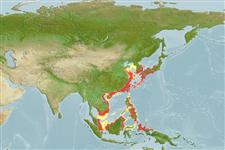Environment: milieu / climate zone / depth range / distribution range
Ecologia
marinhas; estuarina; intervalo de profundidade 5 - ? m (Ref. 12166). Tropical; 39°N - 1°S, 103°E - 138°E (Ref. 54449)
Indo-Pacific: Indian Ocean (Kuwait Bay and Pondicherry), Java Sea (Singapore), East China Sea (Canton north to the Koreas and southern Japan, as far as Osaka on the Pacific coast and Fukuoka in Sea of Japan, also Peter the Great Bay in Soviet waters).
Tamanho / Peso / Idade
Maturity: Lm ? range ? - ? cm
Max length : 60.0 cm TL macho/indeterminado; (Ref. 56557); common length : 30.0 cm TL macho/indeterminado; (Ref. 27773); peso máx. publicado: 140.00 g (Ref. 4883)
Descrição suscinta
Chaves de identificação | Morfologia | Morfometria
Espinhos dorsais (total) : 0; Espinhos anais: 0; Raios anais : 43 - 53. Body slender, belly with usually 24 to 25 + 10 to 15, total 34 to 42 scutes. Eye large, lower jaw projecting. Dorsal fin origin at about midpoint of body or a little behind; anal fin origin a little behind dorsal fin base. Swim bladder with a long tube passing back down right side of body above anal fin base.
Found inshore, entering estuaries and presumably able to tolerate lowered salinities; also found in semi-enclosed sea areas (Ref. 11230). A warm-water species that does not reach the northern part of its range in cool years. Used in Chinese medicine (Ref. 12166).
Ciclo de vida ou comportamento de acasalamento
Maturidade | Reprodução | Desova | Ovos | Fecundidade | Larvas
Whitehead, P.J.P., 1985. FAO Species Catalogue. Vol. 7. Clupeoid fishes of the world (suborder Clupeoidei). An annotated and illustrated catalogue of the herrings, sardines, pilchards, sprats, shads, anchovies and wolf-herrings. FAO Fish. Synop. 125(7/1):1-303. Rome: FAO. (Ref. 188)
Status na Lista Vermelha da UICN (Ref. 130435: Version 2024-1)
Ameaça para os humanos
Harmless
Uso pelos humanos
Pescarias: altamente comercial
Ferramentas
Relatórios especiais
Baixar XML
Fontes da internet
Estimates based on models
Preferred temperature (Ref.
123201): 17.6 - 29, mean 27.9 °C (based on 396 cells).
Índice de diversidade filogenética (Ref.
82804): PD
50 = 0.5000 [Uniqueness, from 0.5 = low to 2.0 = high].
Bayesian length-weight: a=0.00676 (0.00436 - 0.01047), b=3.02 (2.89 - 3.15), in cm total length, based on LWR estimates for this species & Genus-body shape (Ref.
93245).
Nível Trófico (Ref.
69278): 3.8 ±0.61 se; based on food items.
Resiliência (Ref.
120179): médio(a), tempo mínimo de duplicação da população 1,4 - 4,4 anos (tm=2; Tmax=6-7; K=0.2-0.4).
Prior r = 0.88, 95% CL = 0.58 - 1.32, Based on 4 data-limited stock assessments.
Fishing Vulnerability (Ref.
59153): Low to moderate vulnerability (34 of 100).
Climate Vulnerability (Ref.
125649): Moderate vulnerability (38 of 100).
Nutrients (Ref.
124155): Calcium = 104 [61, 212] mg/100g; Iron = 1.41 [0.84, 2.22] mg/100g; Protein = 19.5 [18.1, 20.8] %; Omega3 = 0.364 [0.193, 0.671] g/100g; Selenium = 44.5 [22.8, 87.2] μg/100g; VitaminA = 21.5 [8.1, 52.5] μg/100g; Zinc = 1.15 [0.82, 1.60] mg/100g (wet weight); based on
nutrient studies.
